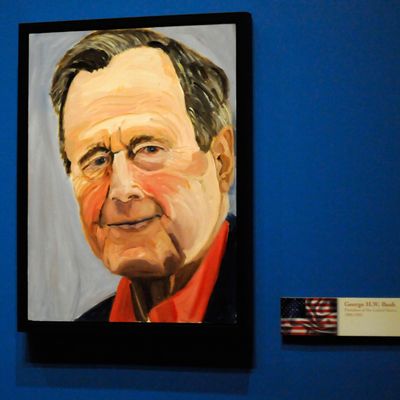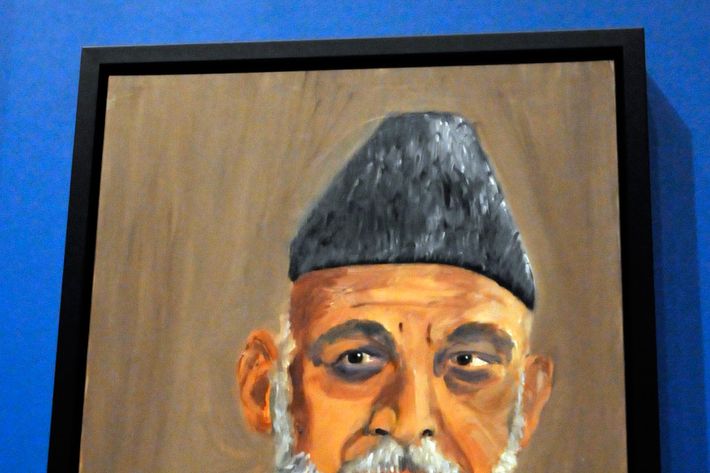
When I look at the paintings of George W. Bush, it’s like seeing an incubus on America, as freakish and off-putting as his presidency was. Yet the art critic in me has to grant that if I stumbled on three or four of Bush’s paintings in a flea market by an anonymous artist, I’d snap them right up. The first batch of his paintings we saw, in 2012, were of landscapes, churches, Bush himself in the bathtub, and other scenes, and I liked them for their sheer weird obliviousness, their zonked-out earnest attempts at figuration, the odd feel for form and space, light, color, and softly contoured edges. If I didn’t know they were by Bush, I’d imagine they were made by a diligent high-school senior, maybe a beauty queen perfecting her talent, maybe a mischievous frat boy spying on his father, possibly an onanist. I liked these amateurish paintings for their perverted pictorial twists and psycho subject matter. Now Bush is having his first-ever solo exhibition of 30 of his new oil paintings, most of which are portraits of world leaders. It’s at his presidential library, with the bogus title “The Art of Leadership: A President’s Personal Diplomacy,” and we are all considering Bush As Artist once again.
When a hacker first made them public in 2012, Bush’s paintings were the first things about the man that didn’t give me the heebie-jeebies. I fancied this misguided ex-President picturing himself in small spaces, alone, ruminating, naked, without guilt or dark nights of the soul, happily embracing his fragility and know-nothingness. I thought that they were the beginning of Bush leaving a painterly trail to his inner thinking. I’d buy the paintings of the man in the bathtub and the one of him in the shower looking back at us plaintively in a shaving mirror. I was stunned by this work at the time. I still am. Try to conceive of Abraham Lincoln taking up painting after his presidency. Then imagine him choosing to render himself naked in a bathtub, and you’ll see how creepy-interesting Bush’s bathtub paintings are.
Still, many art-worlders hate that Bush’s work is granted the status of art at all. Critic Peter Plagens is furious about it: “The whole kerfuffle about George W. Bush’s paintings is the result of a clever political maneuver by the forces of the Right (a.k.a. the Republican Party) to soften the Bush name so that Jeb can make a presidential run … Who the f**k cares about George Bush’s paintings!” I agree. Nevertheless, I’m compelled to examine what’s here, since it seems unlikely that—except perhaps by the alchemy of art, which makes unpredictable things come to light—a man like George W. Bush will ever come to consciousness or make a confession of the destruction he wrought. (Let me note here that I haven’t seen any of them in person.) That’s why, in 2012, I urged him to keep painting, to get good enough to let us see more of what he sees and saw. More recently, when we saw a few more paintings, there was evidence that he was getting worse rather than better: He was, it seemed, relying less on his own vision and more on anonymous photography and clichéd imagery, making pictures of pets and a caricature of Jay Leno.
And now? Once again, the paintings are weird. The bizarrely skewed portrait of Vladimir Putin makes no pictorial sense whatsoever but somehow coheres as a painting, and I’d buy the one of Tony Blair that looks like it has a face painted over another face and reedy pinkish lips that might start speaking, as in the old Clutch Cargo cartoons. But truth always will out. Bush has returned once and probably for all to aping the idea of what a painter does. Now, as during his presidency, he acts the role. He lacks his own ideas, and substitutes a notion of how past leaders have acted. We get an ersatz picture of how he learned to behave like a leader—just as in the funny way he used to hold his arms out when he walked around the White House, or when he was on the golf course threatening terrorists and then telling reporters “Now watch this drive.” The new paintings include a self-portrait. Tellingly, it is the least finished, least focused, and most vague of all his pictures. There’s a labored portrait of his father, the largest head he’s ever painted, as if this is the face and figure that really fills his world. In Putin, the man who had Bush at hello, we see W still trying to fathom how he got so played. We see the Dalai Lama (one can only imagine what he made of Bush), King Abdullah (the painting that looks the most like a Luc Tuymans), and—in another painting I might buy because it has some of the collapsed strangeness and fleshy light of the Blair picture—Japanese prime minister Junichiro Koizumi.

As with all things Bush, the content that comes out of the pictures is not a man exploring his own vision and his deeper feelings. The content that speaks volumes in Bush’s work now is what he’s not painting. His own cronies are missing: Karl Rove, Dick Cheney, Donald Rumsfeld, Colin Powell, Condoleezza Rice, and the Fox News personalities and right-wing talkers who cheered Bush to war. Imagine Bush painting his view of the 2000 election. Or of his landing on that aircraft carrier; of the torture at Abu Ghraib; of bringing the US economy to its knees. Picture a self-portrait of him flying over New Orleans after Katrina or meeting with FEMA director Michael Brown. Think of a self-portrait in the Oval Office, perfecting efforts to stop gay marriage or watching Colin Powell talking about yellowcake uranium at the UN. Or anything to do with bringing America to war under false pretenses and costing the lives of tens of thousands. As Stalin edited people of out photographs to erase them from history, Bush occludes the parts of his presidency that don’t fit his own storyline. He avoids real life and looks away. When I look at Bush’s latest paintings I know I’m looking at the real degenerate art.




